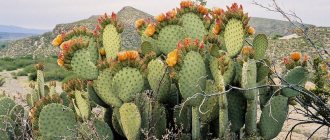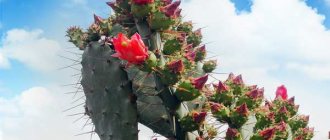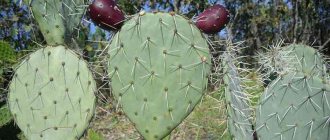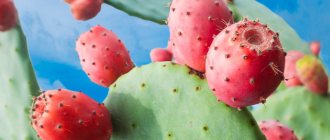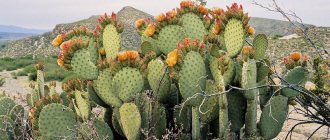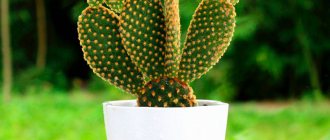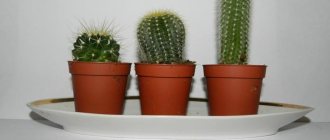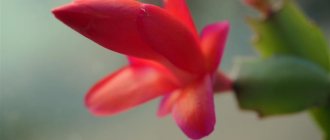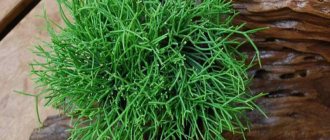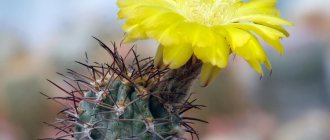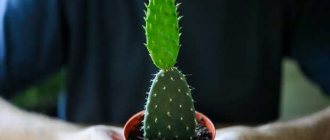In Soviet times, many people grew a strange plant on their windowsills - flat, fleshy cakes covered with sparse thorns. His name was simple - ears, mother-in-law's tongue. The “official” name is prickly pear. The cactus is not particularly beautiful. But during the flowering period, less diligent plant growers look at the wonderful flowers with envy. But few people have ever seen the fruits of prickly pear. They ripen at home very rarely. Is it easy to grow flowering prickly pear at home? Why does the cactus refuse to bloom? Is it possible to harvest prickly pear fruit?
Description of the cactus
Prickly pear is an angiosperm or flowering plant, succulent, and belongs to the Cactus family. There are just over 300 exotic and colorful species of cacti, 190 of which are classified as Opuntia, the largest genus. Cacti are tree-like, shrubby, creeping and upright growing. Most of them have elongated fleshy stems, similar to leaves, which are both a trunk and shoots; they are called members. On all surfaces, buds with a group of spines and glochidia are developed (look up the meaning of unknown words below). The buds may form branches or flowers. Various types of Opuntia grow as creeping vines, shrubs or tall trees, up to 5-6 meters. During flowering, the cactus blooms bisexual flowers, which are subsequently tied into edible, aromatic, juicy berries. They ripen hard and flat seeds, shaped like cactus leaves. It is a mistake to think that Prickly Pear fruits are fruits.
Berries on Opuntia tomentosa
Types of prickly pear
More than 350 species of prickly pear are known in nature. But only a few of them are used in culture.
Opuntia microdasys. Compact branching plant up to 60 cm high for indoor floriculture. The stem consists of oval dark green segments up to 15 cm long with numerous halos-pads of brightly colored glochidia - yellow, red and pearly white (form Albinospina ). The flowers are yellow. The fruits are large red.
Berger's prickly pear (Opuntia bergeriana). Grows up to 1 m. The shoots are elongated, light green, with long yellow spines. It blooms at an early age and profusely. The flowers are orange-red with a green pistil.
White-haired prickly pear (Opuntia leucotricha). The stem fragments are elongated - up to 25 cm. The peculiarity of this species is the long white spines with which all the shoots are densely dotted. The flowers are small, golden yellow.
Opuntia microdasys. Photo: globallookpress.com
Berger's prickly pear (Opuntia bergeriana). Photo: globallookpress.com
Cylindrical prickly pear (Opuntia cylindrica). Photo: globallookpress.com
Indian prickly pear, or fig (Opuntia ficus-indica). Photo: globallookpress.com
Cylindrical prickly pear (Opuntia cylindrica). Plants with cylindrical stems atypical for prickly pears are also called pterocacti.
Indian prickly pear, or fig (Opuntia ficus-indica). The trunk becomes woody at the base. The shoots are olive green in color. Small aureoles contain numerous cream-colored spines. The flowers are bright amber, with a golden tint. In nature it produces a good harvest of very tasty and aromatic fruits.
Gosselin's prickly pear (Opuntia gosseliniana). Plants begin to bloom at 5 years of age. Young prickly pears have reddish shoots, while adults have blue-green shoots with a silvery tint. Only the upper part of the segments is strewn with soft long spines. The flowers are yellow and fragrant.
Homeland and places of origin
North America, or more precisely Mexico, is considered to be the birthplace of Opuntia. Dry areas of deserts, savannas, juniper and pine forests “gave birth” to about half of all types of plants that are resistant to heat and sun. As navigation developed, the cactus spread across the territories of Canada, India, and Australia.
The coat of arms of Mexico depicts a golden eagle perched on a Prickly Pear, devouring a snake. According to legend, the ancient Aztecs founded their city of Tenochtitlan in the place where this action originated. The ancient sun god Huitzilopochtli ordered to build a city where they would see an eagle sitting on a cactus and devouring its prey. Currently, this place is the capital of Mexico, Mexico City. The image symbolizes the victory of good over evil.
Coat of arms of Mexico
Spreading
Since the 1500s it was introduced to Europe, and now grows in Russia in the Caucasus, Turkmenistan and Crimea. The semi-desert climate of Australia was very popular with the neophyte Opuntia, which led to too high rates of its growth on the continent.
Neophyte - plants (usually weeds) that have recently appeared in the local flora as a result of human economic activity or natural migration.
Resistance to ten-degree frosts also affected survival, so chemical and biological methods of inhibiting growth and reproduction were used to curb the “expansion.” In addition to extremely dry climates, Opuntia can be found in the tropics and subtropics, particularly in North America and the Galapagos Islands.
Applications of Opuntia
Thanks to its unique properties, all parts of this cactus are used on the farm. Extracts and oils can be found in the pharmaceutical industry. The fruits and stems are eaten. The cactus is grown for livestock feed. We have prepared extensive material on this topic, which includes many facts that are not reflected in this article.
A couple of interesting facts: • The Indians call the fig-like fruit “tuna”, and depending on the color they add prefixes: amarilla (bright yellow), blanca (white), tinta (black). • In Spain, folk festivals celebrated the beginning of the ripening season for Opuntia berries.
Opuntia fruits
Edible and pleasant to the taste, from a distance they resemble strawberries, some varieties have pineapple or kiwi, gooseberries, the pulp is watery, sweet with sourness, refreshing. Depending on the degree of ripeness, the fruits are used in different dishes: unripe ones are boiled; in meat soups they replace vegetables; ripe ones are eaten raw, boiled and baked. Preserved in the form of preserves and jams. Store like dried fruit. They make tinctures: wine, syrups; squeeze out the juice. You can, as a type of preservation, use freezing fruits (for example, Opuntia fig) in the freezer, the taste will deteriorate slightly, and the amount of vitamins will become slightly less.
In the branches and leaves of Opuntia
A large amount of starch, sugars, proteins, a small amount of vitamin C, which makes them very filling and nutritious. After removing the thorns, Indian tribes feed the cacti to domestic animals.
There is evidence that Opuntia was an important economic product already in the 8th century BC.
Opuntia fruits contain a set of vitamins and microelements. Vitamin C strengthens the immune system, coarse fiber helps with digestion. A dye such as carmine is synthesized from the cells of cactus stems.
How to cook cactus?
First of all, before cooking a cactus, you must carefully remove the spines and the hard part of the shell. As mentioned above, it is best to use young cacti - they are softer and have a distinct fresh taste.
The easiest way is to fry the cactus in a frying pan. Please note that you must first soak it in water (to remove sticky liquid) and then dry it thoroughly. Coconut oil is best for frying; you can also add red peppers, onions and tomatoes.
// Which oil is better for frying?
Smoothies and drinks
Traditionally, alcoholic beverages were made from prickly pear fruits. For example, the national drink of Malta, Ambrosia Bajtra liqueur, is a product of the processing of this particular cactus.
Pieces of pulp can also be used to make smoothies - cocktails based on green vegetables.
Attention, Spikes!
As a protective function, a large number of glochidia grow on the spiny areoles (like many incomprehensible words in one sentence... definitions below). They are difficult to remove from human skin; tweezers are used to remove them. Cold water tightens the skin, which also helps in getting rid of “thorns.”
Areole - a bud or bud of a branch, pubescent or smooth, a distinctive feature of cacti. May grow into a branch, baby or flower. Due to electromagnetic interaction, the hairs on the areolas can attract droplets of water from the surface of the cactus.
Glochidia is a single-celled growth on the buds up to 10 mm long, which is a mini spine with serrations in the upper part. They are easily separated from the trunk or branch of a cactus, dig into the skin and are difficult to remove from there, causing pain. They have a protective function in cacti.
Bloom
From the beginning of spring (late March-early April) until autumn, flowers with petals in several rows appear on Opuntia. The colors of different varieties are very diverse: pale yellow, golden, cream, bright red and even brown or completely white. As a result of flowering, quickly growing fruits are formed on the branches, the color of which also changes from green to dark red or burgundy as they ripen. The probability of flowering depends not only on climatic conditions, but also on the size of the root system; in cramped pots and with weak roots you will not be able to admire the buds.
You need to try to please Opuntia so that it blooms at home. During the appearance of buds, it reacts critically to changes in the care regimen, and when changing the location in the apartment, turning, decreasing or increasing the volume of water, sunlight or fertilizer, it resets them.
The flowers are bisexual, delicate, fall off or curl when touched carelessly. The developing berries contain spherical seeds with a diameter of 2-6 mm, they are covered with a hard shell, protecting the seeds from the aggressive influence of the external environment. This same “cocoon” complicates seed germination in dry and cool conditions.
Opuntia flowers have the property of proliferation, and due to this, the plant develops, forming stems, in an unpredictable manner and at a high rate.
Proliferation is a phenomenon when actively multiplying plant cells, when dividing, form branches with leaves instead of pistils in the center of the flower.
Diseases, pests, how to fight and care for prickly pear cactus during this period
If there is a mealybug on the prickly pear, you can treat the cactus with a solution of green soap or tobacco infusion.
As a rule, most diseases and pests appear in cacti as a result of improper care. And prickly pear is no exception. But don’t be afraid, any pest will have its own protection.
- Mealybug (aka hairy aphid). These are small white insects that can be seen with the naked eye. They mainly settle in colonies on plant stems, sucking fluids from it and slowing down growth. If the situation is completely neglected, then the females of this pest will begin to produce a fungus that pollutes the plant. Aphids on a cactus can only appear if the temperature is too hot or the air humidity is high. Infected plants can be saved from this scourge by spraying with garlic infusion, green soap solution or tobacco infusion. Before spraying, all insects must be expelled manually (with a cotton swab, swab or soft brush).
- Spider mite. Another harmful insect that feeds on plant cells. In addition, it carries a variety of viruses and diseases. The parasite can be identified by small dots on the surface of the cactus and a thin web entwining it. To combat it, spraying with solutions of Karbofos, Intavir and other insecticides is used. Treatment with ordinary alcohol, garlic infusion and soap will also be useful. Aldikrab or Temis is used to apply to the soil.
To combat spider mites, use Karbofos solution
Anthracnose (brown spot). This is a fungal infection of all cacti and can be identified by moist, yellow-brown areas on the plant.
These areas must be removed as soon as possible (carefully cut with a sharp knife). After which the fresh wound should be sprinkled with sulfur, and the entire cactus should be sprayed with fungicides
Often this disease does not come alone, but in company with a tick. Therefore, even if you haven’t noticed it, it still makes sense to treat your green thorn with insecticides.
Rotten. These are probably the most common diseases of cacti. The reason for their appearance is most often poor care, which may include lack of light, excessive watering, etc. There are many rots. Under the influence of, for example, wet rot, the cactus begins to darken and turn into a soggy mass. Another prominent representative of rot is cactus late blight, which immediately affects all plant organs, which begin to rot under its destructive influence. If the rot has not yet spread over a large area of the surface of the cactus, then it can be cut out and sprinkled with sulfur. If the root system is affected by rot, then all infected roots are also removed. After which the cactus should be transplanted into completely new soil, and the cut roots should be thoroughly sprinkled with charcoal powder. The first watering after this procedure should be carried out no earlier than 3 weeks later. In general, the drugs Hom, Oxychom and Fundazol have proven themselves well in the fight against various rots.
Prickly pear grows not only at home but also in open ground, we recommend watching this video, we wish you a pleasant viewing.
As a result, we can conclude that prickly pear is perfect for those connoisseurs of home plants who cannot devote too much time to their green pet. She is easy to care for, very useful, and all problems with her health can be avoided with minimal preliminary efforts. In addition, it will simply become a unique decoration for your home or office.
Opuntia Reproduction
Possibly in two ways: cuttings and seeds. Cuttings are used more often than propagation by seeds. In the same way, the cactus develops new territories in the wild. But let's look at both methods:
When propagated by seeds
This results in a much larger number of young plants of approximately the same age. The second advantage of this method is the good health of the young animals. Opuntia seeds can be planted within two years from the date of collection. As was said, cactus seeds are covered with a hard shell, and in order for the sprout to break through it, you need to perform scarification:
Scarification is stimulating plant growth by breaking the integrity of the hard shell of seeds mechanically or by exposure to a certain temperature.
- A small part of the crust is removed from any edge of the seed by grinding it off with a file or sandpaper. After removing part of the cork layer, you will see a black “dot” - a grain in the center, it is important not to damage it;
- Soak the seeds in a weak solution of potassium permanganate for 1-2 hours;
- Place the planting material in distilled water for a day;
- Place in a porous, damp material such as padding polyester or foam rubber, and then in a plastic bag and leave at a temperature of 20-25 degrees for germination;
- The seeds will germinate within 10-20 days, this happens unevenly, check them periodically.
Seeds with sprouts are planted immediately in separate containers to a depth of 1-1.5 cm. The soil is prepared from charcoal, rotted leaf soil, crushed expanded clay, and coarse sand in equal parts. The composition should be light and breathable. Do not forget to lay out a drainage layer at the bottom. Greenhouse conditions are created until the first two leaves and a small “cactus” appear between them. This is followed by diving (deepening) to the growth point of the first two leaves and abandoning greenhouse conditions. Subsequent care does not differ from the conditions for an adult plant.
Before diving, the lighting is kept plentiful, but without direct sunlight, so as not to damage the first two leaves of the plant.
It is possible to germinate Opuntia seeds directly in the substrate. This method differs from the previous one in that after mechanical “opening” and disinfection with potassium permanganate, the seeds are placed in wet river sand (which is calcined before this). For germination, greenhouse conditions are created with a temperature of 20-25 degrees Celsius, and when shoots appear, the sprouts are transplanted into individual containers. The disadvantage of this method will be poor visualization of the appearance of sprouts at the initial stage of Opuntia growth.
When grown by seeds, the central stem first grows cylindrical in shape, and only then, increasing in diameter, becomes flat.
For propagation by cuttings
Select small healthy branches (babies) of the prickly pear and cut them with a sharp knife. Dry for 3-4 days. After the cut has healed and the shoot has become a little soft (dried), you can begin planting.
For this method of reproduction, the end of spring - the beginning of summer is suitable, at this time the temperature is favorable 20-25 degrees, and sap flow is at a high level.
The pot is chosen to be small in size, with a drainage layer 1-2 cm thick at the bottom. The soil is suitable in the same way as when planting sprouted seeds (found in the previous subsection). It is not necessary to deepen the sprout much, this is only necessary so that it stands more or less vertically. The soil is slightly moistened and the seedling is left in a dark place for rooting. Watering the cuttings should be done a little more often than an adult plant, by 25 percent, but also after the top layer has dried to a depth of 2-3 cm. For more reliable root formation, you can make a mini greenhouse, covering it with a plastic bag or glass jar.
Prickly pear pests
The main pests of prickly pear are spider mites and mealybugs; scale insects also readily settle on the shoots, and nematodes on the roots. Regular inspection of plants will allow you to immediately notice the appearance of pests and take action.
Spider mite. It multiplies quickly in dry, poorly ventilated areas. It feeds on plant cell sap, mainly on young shoots. With severe damage, prickly pears stop growing, and the color of the shoots changes to yellowish or reddish.
Acaricides are suitable for treatment: Neoron, Sunmite, etc. - according to the instructions.
Mealybug. When these small insects accumulate, the cacti seem to be sprinkled with flour. White lumps of oviposition are also clearly visible.
At the initial stage of infestation, insects and eggs can be washed off with a damp brush. Severely affected plants are treated with insecticides - Actellik, Fufanon (6), etc. and covered with plastic wrap for a day.
Against nematodes, the soil is watered twice, with an interval of 7–10 days, with nematicides (Vidat, Nematofagin-Mikopro, etc.), according to the instructions. Scale insects are mainly removed mechanically, and the shoots are then washed with a weak solution of potassium permanganate (3).
Interesting fact
In the recent past, in Mexico, entire prickly pear plantations were grown to breed the hairy aphid - cochineal, from which they obtained a valuable crimson dye - carmine. With the advent of synthetic dyes, the cultivation of cochineal has sharply decreased, but natural carmine is still used in the food and perfume industries, as well as in biochemical research and for staining histological preparations for study under a microscope.
Home care
Lighting
Under natural conditions it grows in desert and semi-desert areas, in mountains, steppes, and hillsides. All these places have abundant lighting, a lot of sun, virtually no shadow and plenty of fresh air.
It follows from this that in apartments or houses it is placed on the southern window sills, less often on the southeastern and southwestern ones. If there is a lack of light, you can’t expect flowering or active growth from Opuntia; this also undermines its health. Even in summer, during prolonged cloudy periods, the cactus is illuminated using artificial lighting for up to 14-16 hours. Before flowering begins, the plant is turned around its axis every 2 weeks, but after that, turns threaten to cause the buds to fall off.
In the spring, when the length of the sunny day increases and the dormant mode changes to the active growth phase, move the Prickly Pear to the windowsill in advance. This will naturally allow her to adapt to the changing intensity of the sun's rays and, in fact, to the duration of daylight hours. With a sudden change in lighting from artificial to natural, burns may form on the surface of the plant.
Temperature
Changes on the thermometer with the change of seasons sets the rate of growth and development of Opuntia in nature. Temperatures in summer are usually in the range of 25-35 degrees Celsius. In winter, rest is optimal at 7-10 degrees at home. In the wild, different species are accustomed to the following conditions:
- Prickly pear from central and western America feels comfortable in temperatures down to -5°C, and even snow cover is not a hindrance to them;
- Temperatures in Mexico never drop below zero degrees. Therefore, for example, frosts are contraindicated for White-haired Prickly Pear;
- in the south of America the climate is very mild and even +7 degrees is considered a cold temperature;
- For Opuntia Kamancha, temperatures down to -30 degrees are permissible!
- A representative of a region with warm winters is Creeping Opuntia.
Summer is a time when there are no special requirements for temperature, but in the autumn-winter period it is necessary to lower it. If you do not provide a period of rest, the cactus will begin to stretch, the leaves at this time will be thinner and the color will be paler. The situation can be aggravated by a lack of light, which will affect the proportions of the trunk, stems and leaves, in which case you will get an unsightly plant.
Home and Outdoor Placement
At home, most often the hottest and brightest place is chosen for Opuntia, for example, the windowsill of a south window. Nearby plants should not require high humidity or shading, as these will be diametrically opposed care conditions. Even if the temperature and amount of light are within acceptable limits, pay attention to the presence of periodic drafts, which negatively affect the health of the cactus. If Opuntia is grown in open ground, that is, in winter the temperature “overboard” is not lower than -5...-7 degrees Celsius, then during the cold period it is covered with dead wood and branches of coniferous trees. By spring, you may notice that the cactus has become a little “sagging” and has lost its elasticity - there’s nothing wrong with that, it’s just that the liquid reserves inside the stems are depleted. The most popular varieties of Opuntia suitable for growing as a garden cactus and wintering outdoors: Polycanthus, Feokantha, Imbricanta, Fragilis, Mayueniopsis.
Opuntia fragilis
Watering
Rare but plentiful rains in the area where Opuntia grows have taught it to store moisture in its body, so watering at home is carried out rarely, but in large quantities. On average, the interval between waterings is one month. The branched and strong root system quickly absorbs water entering the surrounding soil. The signal for the need to water is when the soil in the pot is completely dry. Water is poured directly onto the soil, without getting on the trunk and branches of the cactus. You can use bottom watering; to do this, place the pot with the plant for 5-10 minutes (depending on its size) in a container of water so that the water does not reach the stem. The procedure is carried out almost at sunset, at this moment the photosynthesis of Opuntia is suspended, but the root system, on the contrary, is ready to absorb nutrients and water from the ground.
Alkaline water is not allowed to get on the areoles of the plant, this leads to their enveloping in lime and subsequent death. And as you remember, the buds are the points of growth, respiration and reproduction of Opuntia.
From mid-autumn, watering is gradually reduced, as the evaporation of liquid from the ground decreases. This is facilitated by low temperatures, increased air humidity during rains, and shortened daylight hours. By the beginning of winter, they completely refuse to add water. Cacti under 1 year of age still continue to be watered, their roots are poorly developed, and the above-ground part is not yet able to store enough water to last until next spring. There are times when the trunk and branches of Opuntia begin to lose elasticity, hardness, and shape. This phenomenon is called “loss of turgor.” Due to the increased temperature, internal processes are not able to slow down enough to put the plant into “hibernation”. At such moments, water with a small amount of water, increasing the ambient air temperature to 14-18 degrees Celsius. If this is done at low temperatures, the root system will rot. According to the method described above, in the spring, healthy cacti are brought out of suspended animation (sleep).
For irrigation, you need settled tap water with a pH value of 5-6. Acidification is carried out using ordinary citric acid: a tenth of a teaspoon per liter of water.
Fertilizer
Having no leaves in the usual sense, Opuntia consumes very little energy. The area from which moisture evaporates is also small, and the root system in volume is almost equal to the above-ground part. Taken together, these factors mean that you can feed the cactus very rarely - once a month. Autumn and winter are a time for rest, and there is no need to fertilize.
Special complex mineral fertilizers are checked for the amount of nitrogen in their composition. This element is actively used by vegetable and fruit crops, but Opuntia requires it in small doses. Excess nitrogen causes rapid development of microorganisms and fungi in the soil and can lead to rotting or damage to the roots of the plant. The optimal composition would be 17% Nitrogen, 35% phosphorus, 48% potassium.
Organic fertilizer is applied to chernozem soils with fruit crops. They are not used for clay soils with Opuntia.
Soil and soil
Clayey, sandy and sub-sandy soils are most similar to the natural habitat of Opuntia. Despite the clay in the soil, it is well aerated due to the large particles in its composition. The pH reaction of the correct mixtures is 4.5-6 units. Alkaline and mineral-rich commercial mixtures for cacti are not suitable for planting; when purchasing, carefully read the labels on the packages. Here are a couple of good soil compositions for Prickly Pear:
- leaf, turf soil, clay, sand, large particles (charcoal, fine crushed stone) proportions 2:1:1:1:1;
- clay, red brick, charcoal, turf soil in equal parts.
Transfer
Performed mainly in spring or early summer, before the period of active growth, flowering and formation of branches and children. If these processes begin, the action will have to be postponed either to the fall or to next year. The frequency of replanting Opuntia depends on age: those up to three years old are transplanted into larger pots annually, those older - once every 3-4 years.
A newly acquired plant is not replanted; adaptation to new location conditions occurs within 1-1.5 months.
In addition to recommendations for frequency, it is necessary to take into account the size of the plant in each specific case; actively developing ones that quickly fill the pot with roots are replanted more often than slowly growing ones.
The roots of the cactus develop to a depth approximately equal to the height of the main stem, and can grow significantly in width, so it is better if the diameter of the pot is 2 times the height. The moment of transplantation is timed so that the next watering occurs 7-10 days after planting. The old soil does not change, only the one that falls off from the earthen lump when pulling the Opuntia out of the old pot is no longer used. When planting, the top layer of soil 1 cm thick can be removed, and small pebbles can be placed in this place: there will be virtually no contact between the base of the trunk and the soil, and during watering the likelihood of its rotting will be significantly reduced.
Be careful when transplanting, use rubber gloves that will not penetrate the cactus spines and glochidia.
Before the next watering after transplantation, you need to maintain a buffer time for the Opuntia to adapt for a week. This is necessary to dry the exposed areas of damaged roots. Even experienced gardeners cannot guarantee perfect preservation of the smallest roots of any plant during transplantation, and open areas in moist soil are highly susceptible to fungal diseases or rot. This week the cactus is placed in a shaded place to retain moisture.
Growing problems
Even such an unpretentious cactus as Opuntia can be ruined by improper maintenance and care conditions; here are the common problems that gardeners face:
- The main stem and branches stretch out, become thinner, and take on an irregular shape - poor lighting. When symptoms appear in winter - increased temperature;
- The surface of the cactus is wrinkled, the stems lose their elasticity, black or yellow spots with rotting flesh may appear at the base - excessive watering, especially affects the autumn-winter period;
- Lack of new branches, stunted growth - old soil, lack of fertilizer, small pot, insufficient watering;
- Halos with dying tissue form on the shoots - mechanical damage, pest damage, exposure to a draft or an open window in winter. In summer, it can occur due to lack of moisture;
- Black or dirty brown spots on stems or leaves - rotting of the cactus due to high humidity, excess watering, can be aggravated at low temperatures. Control method: local removal and disinfection of the cut site with chemicals.
Diseases and pests
- The main pest of Opuntia is the Nematode worm. It settles in the roots of the cactus, lays eggs there, and the miniature worms, growing, lead to swelling in the root system. To get rid of the parasite, use water at a temperature of 45-49 degrees, in which the Opuntia roots are placed for 9-12 minutes, while the root collar should remain above the surface. After heat treatment, the swellings are cut off, the open wounds are dried and treated with crushed coal. The soil must be disinfected.
- Sucking pests in the form of mites, mealybugs, scale insects or whiteflies feed on the juice of the Opuntia by piercing micro-holes in its shell. At any stage of development, these parasites can be visually detected on the body of the cactus. Unusual bumps, small crawling insects of white, yellow or brown color are signs of damage. To quickly and effectively destroy parasites, acaricides are used, which are available in a large variety on the shelves, according to the recipes on the packages. The treatment is carried out twice, the second time to destroy the individuals hatching from the larvae. The period between treatments is from a week to 10 days.
- The main diseases of Opuntia are various types of rot: gray, wet, pythium rot; late blight fungus. Rotting of the root system occurs from regular waterlogging of the soil or excess nitrogen in the soil. Late blight develops when water stagnates in the sinuses and “wrinkles” of the stems. Conclusion: improper care leads to Opuntia disease. Recovery occurs after removing the affected areas mechanically, for example with a sharp knife, and treating with fungicides. Before planting, the soil is replaced with sterilized one.
How to plant and replant a cactus
To plant or replant prickly pear, it is better to take a plastic pot. In it, the cactus roots grow more evenly. In addition, plastic is easier to clean and disinfect if the plant is sick. Choose a container that is not too deep and wide; the root system of the cactus is superficial.
Choose the first pot for young prickly pear to be small, 7–10 cm in diameter. The pot for replanting should be only slightly larger than the previous one. Remember: prickly pear blooms when the roots fill the entire space.
Prickly pear, like other cacti, needs light, loose, moisture-permeable soil. Stagnation of moisture at the roots leads to their rotting; in particularly advanced cases, the plant may die.
Prickly pear can be planted in prepared soil for cacti. Or you can make the substrate yourself. You will need sheet soil, turf, peat, sand, pebbles or broken brick, you can take expanded clay. Mix all ingredients in equal parts.
Features of planting and transplanting
- Prepare a plastic pot and disinfect it.
- Be sure to add a drainage layer to the bottom of the pot.
- Fill the container with prickly pear substrate.
- On the eve of transplantation, do not water the cactus. Replant the plant in dry soil.
- Place the planted plant in a slightly shaded place; do not water it for about a week.
- After a week, move it to light, water regularly, but do not allow the substrate to become waterlogged. No fertilizing is required.
When replanting prickly pear, use tweezers
Young prickly pears are replanted annually in the spring until they grow to a pot with a diameter of 15 cm. Adult plants require replanting approximately every three years. Or more often if the prickly pear, for example, is sick.
Be careful when replanting prickly pear! Beware of sharp spines and glochidia. Wear thick gloves and loosely wrap the plant in several layers of fabric. You can use large tweezers, several folded newspapers, or plastic tools.
Creating a cactus garden
Prickly pear, not very elegant during the dormant period, can become part of a flower arrangement. The best neighbors in the kindergarten:
- astrophytum;
- Echinofossulocactus;
- Gymnocalycium;
- Cereus peruviana;
- Chamecereus Sylvester and other desert cacti.
From the history
Researcher Bernardino de Sahagún described Opuntia as a kind of tree. In his book General History of the Affairs of New Spain, using information from the Aztecs, he called the Opuntia "Nopalli" and the fruit "Nochtli". The cactus seemed to him like a tree, with leaves, branches and berries covered with thorns. The traveler wrote that both the fruits and leaves of the plant are edible. New branches can form directly from the leaves, and inside all parts of Nopalli there are a large number of strong, hard fibers - “veins”. At the end of the story, it was announced that the plant is widespread in the local environment.
Benefits of cactus berries
The beneficial properties of the queen of cacti have long been beyond doubt. This wonder is recommended for obese people - the plant extract is included in weight loss medications. Berries have a beneficial effect on the stomach and intestines. They promote the production of insulin, which is why they are recommended for people with diabetes.
The pulp of the fruit tones and quenches thirst. The decoction can even lower high temperatures.
If you wish, you can make jam, jam, liqueurs, marmalades, candied fruits and all kinds of sauces from the fruits and stems of prickly pear. Plant stems no more than 1 cm thick are suitable for food. You can also add them to salads.
The stems, unlike the fruits, are considered vegetables. They can be baked, stewed and boiled - this is an option to surprise your guests! How to store these berries? If frozen, some of the beneficial substances will disappear, but if dried, there will be more benefits.
Several legends and myths.
Rose gave flowers to the prickly pear cactus, in exchange for thorns, at their birthday party, which they had on the same day. According to another version, Opuntia is an old dwarf with thick and prickly bristles. The copper coin in his hand turned into flowers. Another legend tells of cactus flowers as a response to the beauty of Queen Rose, who was admired by everyone around her, but after the Opuntia flowers bloomed, the ruler herself accepted their beauty. The thorns are claws given to the fox because the cactus saved her from a stone that wanted to crush the cheat. Opuntia needed needles to protect itself from attacking ruminants like llamas or alpacas.
Related posts:
- Pineapple is neither a fruit nor a vegetable! We will teach anyone how to grow it themselves. Pineapple has a beneficial effect on the condition of the whole body, improves mood no worse than chocolate, and also muffles the feeling of hunger. We…
- In these Opuntias the devil himself will “break his leg”! We dealt with 32 species In the process of evolution and human influence on nature, the classification of Opuntia cacti has undergone a change. Previously, 190 “pure” species were known...
- Heather - 4 ways to propagate a plant with unique medicinal properties Enjoy the purple or pink flowers of this beautiful wild shrub when you grow it at home. Contents1 Description of the plant2 Origin of the name3 Homeland...
- And where is it not used? A little more and they will call it Mega Prickly Pear. Opuntia (from Latin Opuntia) is the largest genus of the Cactus family. Most of its species consist of flat segments covered with tubercles (areoles) and...
Cuttings
Cuttings are considered the easiest way to propagate prickly pear. However, with prolonged and frequent propagation of the cactus by cuttings, the quality of the plant becomes lower and lower.
How to select and prepare cuttings?
When propagating by cuttings, it is important that the children cut for planting are fully mature. The segments can be used only after the cylindrical leaves growing from the areoles have completely fallen off
- You need to cut the cuttings with a sterile blade, and sprinkle the cutting areas of both parts of the plant with crushed charcoal or sulfur powder.
- The cutting must be dried in a vertical position, placing it in a glass.
- When the cut site is healed, the shoot can be rooted.
Step-by-step instruction
After the place where the cutting is cut has dried, it can be rooted by performing the following steps:
- prepare disposable plastic cups with pre-made drainage holes in the bottom;
- fill the cups with soil mixture, as for an adult plant;
- Deepen the cuttings into the substrate by 2-3 cm.
The conditions for rooting a cutting are the same as for an adult plant, but without feeding. After 3-4 weeks, the first roots should appear.
Important! The cutting will be more viable if you cut it growing closer to the top of the cactus.
We invite you to watch a video about cuttings and rooting of prickly pears:

